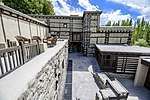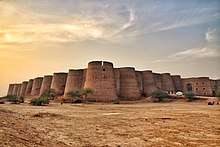Shigar Fort
The Shigar Fort (Balti and Urdu: فونگ کھر) means The Fort on Rock[1] is an old fort of Baltistan and Pakistan located in the town of Shigar. It was built in the 17th century by the Raja of Amacha Dynasty of Shigar.
The fort has been restored by Aga Khan Cultural Service Pakistan (AKCSP-P), the Pakistan arm of the Aga Khan Historic Cities Programme. After restoration, the Fort was converted to a museum and luxury hotel managed by Serena Hotels. The restoration process took place from 1999 to 2004 and cost approximately US$1.4 million.[2]
Locations
The Old Fort-Palace
The original Fong-Khar was founded on top of a platform which rises 5m from the ground and partly surrounds a gigantic cone-shaped rock (thus, the origins of the name, Fong-Khar, or “Palace on the Rock”). Although the Old Fort-Palace as it is now restored appears to be one structure, upon closer examination, it is actually a collection of three separate buildings, built adjacent to each other in different times and with different engineering and workmanship. During the restoration of the site, these three structures were identified as Modules I, II, and III.
Module I is the oldest part of the original structure estimated as being 400 years old. It can easily be interpreted as a single, clearly conceived and executed structure, with a distinct and noble architectural expression. Original usage of this structure can be identified through its sequence of rooms including entrance hall, grand audience hall, retiring rooms for the ruler, and kitchen.
Module II is estimated to have been constructed approximately 100 years after the original Fong-Khar, with Module III following another 150 years later. Both Modules II and III were composed of residential rooms for the royal family, some more elaborate than others.
Old House
The building to the south of the Old Fort-Palace is now known as Old House. Its lower floor had accommodated a horse stable, a cattle pen, and storage for animal feed. It appears to have existed as the royal stable for as long as Fong-Khar itself. The upper floor of this structure was added much later by the raja as new residential accommodation when the Old Fort-Palace was abandoned in the middle of the 20th century.
Amacha Garden and Baridari
It is not known when this decorative square pool – the central feature of the garden – was built, or what its initial appearance was like. Early in the 20th century, a pavilion was built on the central platform of the pool by Raja Muhammad Adam Khan, the father of the present Raja Muhammad Ali Saba. At the time of the takeover of the site by the conservation team, exquisitely carved marble bases that would have supported free-standing and attached columns could still be found on the central platform. The artistic quality of these marble bases approaches the perfection of Kashmiri buildings of the high Mughal style. Knowing that nothing of a quality approaching that of these column bases was built anywhere else in Shigar at the time the pavilion was built in the early 20th century, one can deduce that the column bases have a provenance in an earlier building.
The Raja’s Mosque
The Raja’s public mosque is a handsome and ornate building adjacent to the entrance to the complex and is of significant antiquity and artistic value. It is similar in form and ornament to other mosques in the Shigar area: a single four-bayed room with a central column support and a veranda on the eastern side.
Gallery
See also
| Wikimedia Commons has media related to Shigar Fort. |
References
- "The Shigar Fort Residence".
- Shigar Fort Residence – Our Responsible Tourism Philosophy (accessed Sep 9, 2013)















